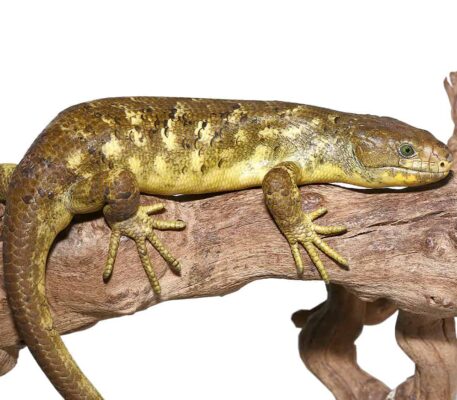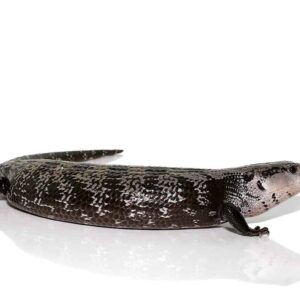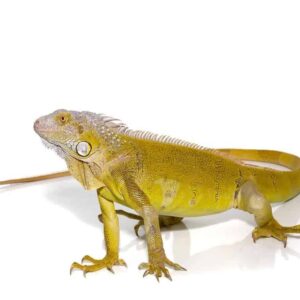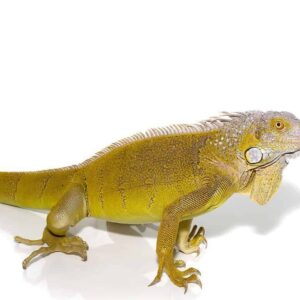Banana Monkey Tail Skink For Sale
$799.99
WE HAVE BANANA MONKEY TAIL SKINK FOR SALE. HERE ARE SOME HIGHLIGHTS:
- Corucia zebrata
- Farm Bred
- Approximately 18 – 20 Inches In Length From Head To Tail
- Adults Can Reach Up To Lengths Of 32 Inches In Total
- These Are Voracious Foragers Feeding On Fresh Fruits And Vegetables
FUN FACTS!
- These Skinks Have Prehensile Tails Meaning They Can Grip And Grab Things With Their Tails
- Gorgeous Animals Not Frequently Seen Here At Underground Covered In Rich Green And Brown Patterns Giving Them Perfect Camouflage
- Naturally Occurring Out Of The Solomon Islands
- These Skinks Have Prehensile Tails Meaning They Can Grip And Grab Things With Their Tales
- Females Are Viviparous Meaning That They Bear Live Young
- With Proper Care These Can Live More Than 20 Years In Captivity
Description
Banana Monkey Tail Skink
The Banana Monkey Tail Skink, scientifically known as Corucia zebrata, is a fascinating reptile native to the Solomon Islands. This unique creature is renowned for its distinctive physical characteristics and captivating behavior, making it a subject of interest for herpetologists and reptile enthusiasts alike. The skink’s name is derived from its prehensile tail, which resembles that of a monkey, allowing it to grip branches and navigate its arboreal habitat with ease.
Physically, the Banana Monkey Tail Skink is notable for its robust body, which can grow up to 32 inches in length, including the tail. Its skin is adorned with striking patterns that range from green to brown, providing excellent camouflage in its natural environment. The scales are smooth and glossy, offering a tactile experience that is both intriguing and unique among reptiles.
Native to the dense forests of the Solomon Islands, the Banana Monkey Tail Skink thrives in humid, tropical climates. These skinks are arboreal, spending the majority of their lives in the trees, where they find both food and shelter. Their diet primarily consists of leaves, fruits, and flowers, which they forage using their sharp, curved claws and keen sense of smell.
Understanding the natural habitat and physical characteristics of the Banana Monkey Tail Skink is crucial for anyone interested in these reptiles. Their unique adaptations, such as the prehensile tail and vibrant coloration, not only help them survive in the wild but also make them an intriguing species to study. As we delve deeper into the world of the Banana Monkey Tail Skink, we uncover more about their behavior, diet, and care requirements, providing a comprehensive guide for enthusiasts and researchers alike.
The Banana Monkey Tail Skink, scientifically known as Corucia zebrata, is indigenous to the Solomon Islands, an archipelago in the South Pacific. These skinks predominantly occupy the islands of Guadalcanal, Malaita, and Choiseul. Their natural habitat is primarily the dense, humid rainforests, where they find abundant foliage for both shelter and food.
The terrain of these regions is characterized by lush, tropical vegetation that provides a perfect environment for the Banana Monkey Tail Skink. These creatures are arboreal, meaning they spend a majority of their time in trees. The dense canopy of the rainforest offers ample cover from predators and harsh weather conditions, while also providing a rich supply of fruits and leaves, which are essential to their diet.
The climate in the Solomon Islands is typically tropical, with high humidity and consistent rainfall throughout the year. These conditions create a stable and nurturing environment for the skinks. The temperature usually ranges between 25 to 30 degrees Celsius (77 to 86 degrees Fahrenheit), which is ideal for their thermoregulatory needs.
In their natural ecosystem, the Banana Monkey Tail Skink plays a crucial role. They contribute to seed dispersal through their frugivorous diet, aiding in the propagation of various plant species. Additionally, as both prey and predator, they help maintain the balance within their habitat’s food web. Their presence indicates a healthy and thriving rainforest ecosystem, underscoring the importance of conservation efforts to protect these regions.
Physical Characteristics and Behavior
The Banana Monkey Tail Skink, scientifically known as Corucia zebrata, is a fascinating reptile with a unique set of physical characteristics and behaviors. Typically, these skinks can grow up to 32 inches in length, making them one of the larger species of skinks. Their robust bodies are covered in smooth, overlapping scales that exhibit a striking greenish-yellow coloration with dark, zebra-like stripes. This vivid coloration helps them blend into their natural habitat, providing a form of camouflage against predators.
One of the most distinguishing traits of the Banana Monkey Tail Skink is its prehensile tail. This specialized tail is highly flexible and capable of grasping branches, which aids them in climbing and navigating through their arboreal environment. The tail is not just a tool for balance but also acts as a fifth limb, enhancing their ability to move adeptly through the trees.
Behaviorally, the Banana Monkey Tail Skink is known for its social structure, which is quite complex compared to other skink species. They are often found in familial groups consisting of a breeding pair and their offspring. These groups exhibit cooperative behaviors, such as shared basking spots and communal nests. This social interaction is crucial for their survival, as it provides protection and increases the chances of successful reproduction.
During the day, Banana Monkey Tail Skinks are primarily diurnal, engaging in activities such as foraging for food, basking in the sunlight to regulate their body temperature, and interacting with other members of their group. They have a varied diet that includes fruits, leaves, and occasionally small insects. Their foraging behavior is methodical, and they are known to use their keen sense of smell to locate food sources.
Another unique habit of the Banana Monkey Tail Skink is their vocalization. Unlike many reptiles that are generally silent, these skinks can produce a range of sounds, including clicks and chirps, to communicate with each other. This vocal communication plays a vital role in maintaining group cohesion and alerting others to potential threats.
Overall, the Banana Monkey Tail Skink’s distinctive physical characteristics and intriguing behaviors make them a remarkable species worthy of study and conservation.
Diet and Feeding Habits
The Banana Monkey Tail Skink, or Corucia zebrata, exhibits a primarily herbivorous diet in its natural habitat, primarily consuming a variety of plant-based foods. These skinks are commonly found in the Solomon Islands, where the lush, tropical environment provides an abundance of dietary options. Their primary food sources include leaves, fruits, flowers, and young shoots from various plants. The skinks demonstrate a particular preference for tender, nutrient-rich foliage and fruits, which significantly contribute to their overall health and well-being.
In the wild, Banana Monkey Tail Skinks exhibit specific feeding behaviors that are adapted to their arboreal lifestyle. They are known to forage during the daytime, utilizing their keen sense of smell and sight to locate food. These skinks are slow, deliberate feeders, often spending considerable time chewing and ingesting their plant material to aid in digestion. This methodical approach ensures they extract the maximum nutrients from their diet, which is essential for maintaining their health and supporting their relatively slow metabolism.
Occasionally, these skinks may consume small insects or other invertebrates, although this is not a significant component of their diet. Such opportunistic feeding can provide additional protein and other nutrients, supplementing their primarily plant-based nutrition. However, it is important to note that a diet overly rich in animal protein can be detrimental to their health, leading to potential issues such as kidney damage.
The diet of the Banana Monkey Tail Skink is not only critical for their immediate nutritional needs but also plays a vital role in their long-term health and reproductive success. Adequate intake of vitamins, minerals, and other essential nutrients ensures healthy growth, robust immune function, and the ability to reproduce successfully. In captivity, replicating their natural diet as closely as possible is crucial for their well-being, requiring a careful selection of appropriate plant materials and occasional supplementation to ensure a balanced diet.
Reproduction and Lifespan
The reproductive cycle of the Banana Monkey Tail Skink is a fascinating aspect of its biology. These skinks are viviparous, meaning they give birth to live young rather than laying eggs. Mating behaviors in the Banana Monkey Tail Skink are complex and involve a series of ritualistic displays and physical interactions between prospective mates. These displays often include head bobbing and tail whipping, which play a crucial role in the courtship process.
Once mating is successful, the gestation period for the Banana Monkey Tail Skink lasts approximately six to eight months. During this time, the female carries the developing embryos internally, providing them with necessary nutrients until birth. A typical litter consists of one to three offspring, although larger litters are not uncommon under optimal conditions.
Parental care in Banana Monkey Tail Skinks is relatively limited. After birth, the young are mostly independent but may remain close to the mother for a few days to a week. The newborn skinks are fully formed and capable of fending for themselves, although they are more vulnerable to predators at this stage.
The growth stages of the young Banana Monkey Tail Skinks involve several molts, during which they shed their skin to accommodate their increasing size. This process occurs multiple times throughout their juvenile years until they reach full maturity, which typically happens around two to three years of age.
In terms of lifespan, the Banana Monkey Tail Skink can live for a considerable period, particularly in captivity where they are free from natural predators and environmental stresses. In the wild, their lifespan ranges from 10 to 15 years, while in captivity, they can live up to 20 years or more with proper care and nutrition.
Understanding the reproductive and lifespan characteristics of the Banana Monkey Tail Skink provides valuable insights into their biology and helps in developing effective conservation strategies, ensuring these unique reptiles continue to thrive in both wild and captive environments.
Conservation Status and Threats
The Banana Monkey Tail Skink, scientifically known as Corucia zebrata, currently holds a concerning conservation status due to various threats it faces in its natural habitat. Listed as Vulnerable on the IUCN Red List, this unique species is primarily threatened by habitat destruction. The deforestation for logging, agriculture, and urban development in the Solomon Islands significantly reduces the available habitat for these skinks, forcing them into smaller, fragmented areas.
Climate change also poses a severe threat to the Banana Monkey Tail Skink. Alterations in temperature and precipitation patterns can disrupt their ecological balance, affecting food availability and habitat conditions. These environmental changes can lead to increased stress and mortality rates among the skink population. Additionally, the rising sea levels associated with climate change threaten the low-lying islands where these skinks reside, potentially leading to habitat inundation.
Predation is another significant threat. The introduction of invasive species, such as rats and cats, has increased predation pressure on the Banana Monkey Tail Skink. These introduced predators are efficient hunters, and their presence has led to a noticeable decline in skink populations. Furthermore, human activities such as illegal pet trade also contribute to their decreasing numbers, as these skinks are captured and sold due to their unique appearance and behavior.
Despite these challenges, various conservation efforts are underway to protect the Banana Monkey Tail Skink. Local and international wildlife organizations are collaborating to implement habitat preservation strategies, including the establishment of protected areas and reforestation projects. Public awareness campaigns aim to educate communities about the importance of conserving this species and the threats they face. Additionally, research initiatives are ongoing to better understand the species’ ecology and develop effective conservation strategies.
Through continued efforts and collaboration, there is hope for the recovery and preservation of the Banana Monkey Tail Skink, ensuring that future generations can witness the beauty and uniqueness of this remarkable species.
Captive Care and Husbandry
When considering a Banana Monkey Tail Skink as a pet, it is crucial to understand the specific care and husbandry requirements to ensure its well-being in captivity. A well-structured habitat is fundamental for the skink’s health. A large, vertically oriented enclosure is recommended, mimicking their natural arboreal habitat. The enclosure should be at least 3 feet tall, 2 feet wide, and 2 feet deep, equipped with sturdy branches, vines, and platforms to encourage climbing and exploration. Additionally, providing hiding spots with cork bark or hollow logs is essential for the skink to feel secure.
Maintaining appropriate temperature and humidity levels is vital for the Banana Monkey Tail Skink’s health. The enclosure should have a temperature gradient ranging from 75°F to 85°F, with a basking spot reaching up to 90°F. Nighttime temperatures can drop to around 70°F. A reliable thermostat and thermometer will help monitor and regulate these conditions. Humidity levels should be kept between 60% and 80%, replicating the skink’s natural, tropical environment. Regular misting and the use of a hygrometer are recommended to maintain and track humidity levels accurately.
Diet in captivity should closely resemble the skink’s natural diet. Banana Monkey Tail Skinks are primarily herbivorous, thriving on a variety of leafy greens, vegetables, and occasional fruits. Suitable greens include collard greens, dandelion greens, and mustard greens, while vegetables like squash, bell peppers, and carrots can be added for variety. Fruits such as bananas and berries can be offered as occasional treats. It is important to provide a balanced diet supplemented with calcium and vitamin D3 to prevent nutritional deficiencies.
Ensuring the health and well-being of your Banana Monkey Tail Skink involves regular observation and maintenance. Watch for signs of illness such as lethargy, loss of appetite, or abnormal stool. Regular veterinary check-ups with a reptile specialist are advisable. Keeping the enclosure clean by removing uneaten food and waste promptly will also help maintain a healthy environment for your skink. With proper care and attention to their specific needs, Banana Monkey Tail Skinks can make fascinating and engaging pets.
Fun Facts and Trivia
The Banana Monkey Tail Skink, also known as the Solomon Islands Skink, is one of the most intriguing reptiles due to its distinctive characteristics and behaviors. One of the most remarkable traits of this skink is its prehensile tail, which functions almost like an additional limb. This tail aids in climbing and gripping branches, showcasing the skink’s arboreal lifestyle. Unlike many other reptiles, the Banana Monkey Tail Skink is viviparous, meaning it gives birth to live young rather than laying eggs. This is a relatively rare trait among reptiles and adds an extra layer of fascination to its reproductive habits.
Interestingly, the Banana Monkey Tail Skink is known for its relatively social nature. In the wild, they often live in family groups, a behavior that is not commonly observed in other skink species. This social structure is believed to offer protection and support, enhancing their chances of survival in their natural habitat. Additionally, these skinks communicate with each other using a range of vocalizations, including chirps and clicks, which is quite unusual for reptiles.
Historically, the Banana Monkey Tail Skink has been a part of local folklore in the Solomon Islands. Indigenous peoples have long admired these skinks for their unique appearance and behaviors, often attributing mystical qualities to them. Their striking green and yellow coloration, coupled with their slow, deliberate movements, has made them a subject of intrigue and wonder.
Another captivating aspect of the Banana Monkey Tail Skink is its diet. These skinks are primarily herbivorous, feeding on a variety of leaves, flowers, and fruits. However, they have been observed occasionally consuming insects, showcasing their adaptability. Their dietary preferences play a crucial role in maintaining the ecological balance within their habitat, highlighting their importance in the ecosystem.
Lastly, the Banana Monkey Tail Skink has a surprisingly long lifespan for a reptile, often living up to 25-30 years in captivity. This longevity, combined with their unique traits and behaviors, makes them a fascinating subject for both amateur herpetologists and seasoned researchers alike.









